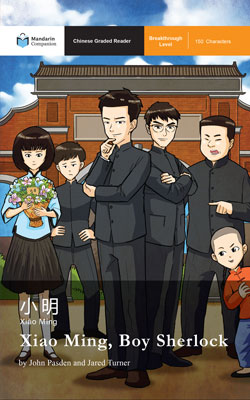Are you ready to embark on the wildly fantastic journey that is Chinese reading for beginners?
Awesome.
It’s not always easy and sometimes there are tears, but if your sincere goal is to advance your language proficiency, reading Chinese is an effective tactic.
Keep scrolling to learn how to engage in Chinese reading practice. You’ll increase your fluency in as little as 一二三 (yī’ èr sān).
FAQs on Chinese Reading for Beginners
Why is reading in Chinese so hard?
Some say learning Chinese is easy. Many others, even famous author David Moser, agree that it can be really, really hard. The truth is that it’s somewhere in between. Many learners of the Chinese language particularly struggle when it comes to Chinese reading because the characters are so foreign. There’s no “alphabet” to rely on or use to “sound words out” like we’re accustomed to in English. Further, while radicals can help, it can sometimes feel impossible to make sense of the meaning of the word by looking at the character alone.
» Listen to Our Interview with David Moser
According to SinoSplice, to fluently read 99.5% of everything thrown at you in books or articles written for Chinese natives, you will need to have mastered at least 3,500 characters. That’s a LOT!

Extensive reading is a tried and true strategy every learner should incorporate into their study plan. Extensive reading focuses on reading quickly at a high level (98%) of comprehension without frequently stopping to look up characters.
This is different than intensive reading which is reading at a 90-98% level of comprehension. Most readers are familiar with this type which is slower and requires a dictionary or reading aides that require the reader to frequently stop and look up words and characters. This is the type normally found in articles found in textbooks and on the web, and while helpful, is not as effective as extensive reading.
Should I Chinese reading practice with pinyin?
Pinyin is essential but every learner should be careful about building an over reliance wherein it becomes the “crippling crutch“. Avoid reading materials with pinyin over the characters if you are serious about increasing your Chinese reading skills.
It may seem counterintuitive at first, but if you need the pinyin in order to read everything, then you should look for something closer to your level. If you develop an over reliance on pinyin, you’ll never really learn to read the characters.
» Read More: Chinese, Y U So Hard?
Yes, we need pinyin, and we’re very happy we have it, but too much of it can be counterproductive to our literacy development. The appearance of pinyin causes you to get lazy about memorizing the character, its sound, and its meaning—we know it can be tempting, but avoid conducting Chinese reading practice with pinyin. You’ll thank us later.

Where can I find beginner Chinese reading material?
Finding books or stories that are appropriate as Chinese reading practice for beginners can be difficult to find. We’ve worked really hard to fill that gap with our “Breakthrough level graded Chinese readers,” books designed specifically for those just getting their Mandarin legs.
Graded readers have proven time and again their usefulness in improving Chinese reading skills for all levels, but especially beginners who can track their progress as they level up their fluency levels. It’s hard to describe the level of satisfaction you will feel when you advance up to Level 1 or Level 2 when you’ve started using the books as Chinese reading practice for beginners. Who knows, maybe you’ll end up like Jared (one of our founders and authors, who used graded readers to become fluent in Chinese in less than three months!).
7 tips to help with Chinese reading for beginners
1. Learn pinyin and tones.
These are essential tools. Without pinyin, we simply cannot know the proper pronunciation of a character. However, pinyin is not pronounced the way it looks to an English speaker. Take the time to master pinyin, understand how it is pronounced, and feel comfortable reading and using it.

2. Learn common phrases and sentences in pinyin.
Find things you want to say and take the time to learn them. Practice speaking these sentences until you are very familiar with them. Use them in different ways and change out various objects and verbs in the sentences. Become so familiar that you could do this in your sleep.
3. Read the sentences in characters.
With these sentences you have learned and know well, eliminate the pinyin and start reading the characters. Match the sound with the squiggle. Read them over and over and start rearranging the sentences by changing the objects and verbs. Don’t fall into the pinyin trap!
4. Read, re-read, and read again
Go to point #4 in this article for great tips from a teacher on this. Whether you are trying to read Chinese online or in a text book, it’s important that you take your time. Many beginner Chinese readers will extol the value of re-reading texts to fully grasp the material.
One strategy is to read once for context without stopping to clarify missing vocabulary. Next, re-read with the intention of pausing to define any characters, phrases, or grammar structures that are new to you. Lastly, re-read for a third time, putting the first two pieces together.
It might seem arduous now, but it will help improve your vocab and retention in the long run.

5. Learn radicals
“So it’s not “this great way to learn Chinese”; it’s the only way to really learn Chinese characters, unless you’re going to stop at a few dozen. Just as one does not typically learn to read English by skipping the alphabet, or begin studies in classical music by skipping musical notation, one does not tackle reading Chinese without learning about radicals.” —John Pasden
If you want to read in Chinese, you should take the time to understand and become proficient in radicals (部首), also referred to as character components. Radicals are distinct graphic components of Chinese characters. They’re your friends because they often give indications or clues to the meaning and/or sound of a character.
Radicals: Know them. Use them. Love them.
6. Read at the right level for you
Just like no newbie to the English language wants to jump right in to read Chaucer’s Canterbury Tales or a James Joyce novel, you probably don’t want to read a book that is beyond your current language capabilities. If you do, you’re at risk for disappointment, frustration, and temptation to just “give up.”

Instead, set yourself up for success. The graded readers approach allow you to pick texts that are right for your current proficiency and character acumen. These stories are specifically designed to be not too hard (though you can expect some new-to-you vocabulary) but not too easy (the concepts won’t be beneath you and your skill level). Think of these books as the Goldie Locks of Chinese fluency: juuuust right.
» Read More: Reading Pain or Reading Gain? Reading at the Right Level
7. Read something you enjoy
Raise your hand if even reading in your native language can feel like a chore sometimes. ?♂️ This reality makes it essential that you choose texts, stories, and novels that you think you will like to read. Leave the boring stories for the next guy. If reading is fun, you’re more likely to do it, take your time with it, and fully realize the benefits of it.
Recommended Chinese reading books for beginners
If you’re looking for easy Chinese books, you’ve come to the right corner of the internet. We always recommend starting your Chinese reading practice with low level graded readers. These gradually more challenging Chinese stories will not only help you more deeply know the characters already in your repertoire, but they strategically and helpfully provide additional vocab along the way.
Extensive reading is the secret sauce to mastering Chinese fluency, so by starting with these beginner Chinese reading materials, you’ll be well on your way to becoming a 中国通 (Chinese genius!).

In Search of Hua Ma
A fiction story inspired by popular stories like Alice in Wonderland and The Lion, the Witch, and the Wardrobe, a young boy is mid-walk through the mountains when he comes across a traditional home. Suddenly, an old lady beckons him in and challenges him to find “Hua Ma.” The boy is suddenly transported to the Chinese island of Hainan and sets out on his quest.
A Breakthrough level Chinese graded reader, this book challenges beginners who have learned up to 150 characters.

Just Friends?
While in college, two best friends meet a beautiful new student. Though they promise one another not to pursue the beautiful new girl in school, one can’t help himself. What unfolds is two great guys seeking the affection of one girl. Who will win, and will they stay friends?
Thanks to its familiar story of love won and love lost, this breakthrough level graded reader provides easy Chinese reading for beginners.

My Teacher is a Martian
Space is cool, right? That’s what the main characters of this Chinese reading practice story think—that is, until their new teacher knows an oddly impressive amount of information about not only the planet Mars, but all of outer space in general.
Is their teacher actually from another planet? Is it all in their heads? After all, it can’t possibly be true to have a teacher who is a martian. Or is it? You won’t know til you take this awesome book for a spin!

The Misadventures of Zhou Haisheng
Mischief and wit go together like dumplings and black vinegar. That’s the moral of this story, which follows a young boy through his antics at his parent’s Chinese shop.
From inventing recipes to helping deliver orders and more, find out if the main character, Zhou Haisheng, can save his family’s restaurant when a similar noodle shop opens in the neighborhood.
Pro tip: Reward yourself for reading this book with your own piping hot bowl of 拉面 lāmiàn (noodles).

Xiao Ming, Boy Sherlock
If you love a good mystery, this is the breakthrough Chinese graded reader for you. Follow Xiao Ming (name) as he helps uncover the school thief with the power of observation and deduction. You’ll never guess who is behind all the shenanigans!
We love combining easy Chinese books and a good “Whodunnit” story—no wonder this is one of our most popular graded readers to date.
Chinese reading for beginners: You can 读 (dú) it

Chinese reading practice is crucial for improving your overall language skills, not to mention impressing your mother when you go out to dinner at your local Chinese restaurant. What other resources for reading Chinese for beginners have you found? Let us know in the comments!
Find More Easy Chinese Reading for Beginners
